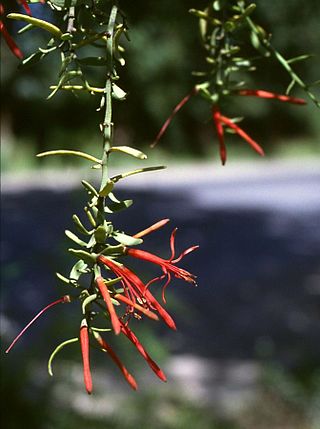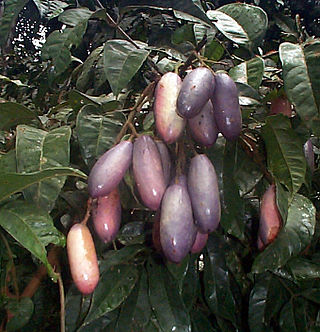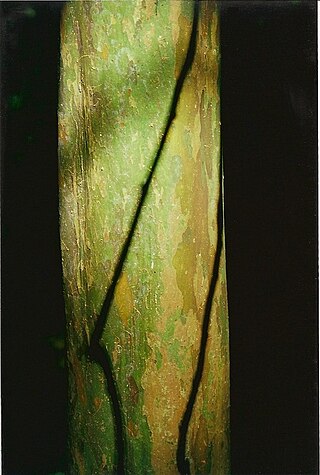
Rosaceae, the rose family, is a medium-sized family of flowering plants that includes 4,828 known species in 91 genera.

Loranthaceae, commonly known as the showy mistletoes, is a family of flowering plants. It consists of about 75 genera and 1,000 species of woody plants, many of them hemiparasites. The three terrestrial species are Nuytsia floribunda, Atkinsonia ligustrina, and Gaiadendron punctatum Loranthaceae are primarily xylem parasites, but their haustoria may sometimes tap the phloem, while Tristerix aphyllus is almost holoparasitic. For a more complete description of the Australian Loranthaceae, see Flora of Australia online., for the Malesian Loranthaceae see Flora of Malesia.

Lygodium is a genus of about 40 species of ferns, native to tropical regions across the world, with a few temperate species in eastern Asia and eastern North America. It is the sole genus in the family Lygodiaceae in the Pteridophyte Phylogeny Group classification of 2016. Alternatively, the genus may be placed as the only genus in the subfamily Lygodioideae of a more broadly defined family Schizaeaceae, the family placement used in Plants of the World Online as of November 2019.

The Celastraceae are a family of 98 genera and 1,350 species of herbs, vines, shrubs and small trees, belonging to the order Celastrales. The great majority of the genera are tropical, with only Celastrus, Euonymus and Maytenus widespread in temperate climates, and Parnassia (bog-stars) found in alpine and arctic climates.

Photinia is a genus of about 30 species of small trees and large shrubs, but the taxonomy has recently varied greatly, with the genera Heteromeles, Stranvaesia and Aronia sometimes included in Photinia.

Garuga is a genus of shrubs and trees in the incense or torchwood family Burseraceae. Its members are found from India to the southwest Pacific.

Parkia is a genus of flowering plants in the family Fabaceae. It belongs to the mimosoid clade of the subfamily Caesalpinioideae. Several species are known as African locust bean.

Prunus africana, the African cherry, has a wide distribution in Africa, occurring in montane regions of central and southern Africa and on the islands of Bioko, São-Tomé, Grande Comore, and Madagascar. It can be found at 900–3,400 m (3,000–10,000 ft) above sea level. It is a canopy tree 30–40 m in height, and is the tallest member of Prunus. Large-diameter trees have impressive, spreading crowns. It requires a moist climate, 900–3,400 mm (35–130 in) annual rainfall, and is moderately frost-tolerant. P. africana appears to be a light-demanding, secondary-forest species.
Prunus arborea is a species of plant in the family Rosaceae. It is found in Indonesia, Malaysia, Singapore, and Thailand.
Prunus clementis is a species of plant in the family Rosaceae. It is found in Sulawesi and the Philippines.
Prunus grisea is a species of plant in the family Rosaceae. It is found in Malaysia, the Philippines, Singapore, and Taiwan.
Prunus laxinervis is a species of plant in the family Rosaceae. It is found in Indonesia and Malaysia.
Prunus pulgarensis is a species of plant in the family Rosaceae. It is endemic to the Philippines. It is threatened by habitat loss.
Prunus rubiginosa is a species of plant in the family Rosaceae. It is endemic to the Philippines.

Dacryodes is a genus of about 60 species of trees in the family Burseraceae. The generic name is from the Greek dakruon meaning "tear(drop)", referring to how resin droplets form on the bark surface.

Gossia is a genus of rainforest trees in the myrtle family first described as a genus in 2003. It is native to northeastern Australia as well as several islands of Papuasia and New Caledonia.

Jigme Namgyel Wangchuck is the first child and heir apparent of King Jigme Khesar Namgyel Wangchuck of Bhutan and his wife, Queen Jetsun Pema. He has been the Crown Prince of Bhutan since his birth in 2016. His name was announced on 16 April 2016. Prior to the announcement, he was known only as The Gyalsey, which means "prince". Before his birth, his paternal uncle Prince Jigyel Ugyen of Bhutan was the heir presumptive to the throne. In honor of his birth, 108,000 trees were planted by thousands of volunteers in Bhutan. In 2017, in honor of his first birthday, a new damselfly species was named after the crown prince, Megalestes gyalsey. He is expected to become the sixth Druk Gyalpo .He has a younger brother, Prince Dasho Jigme Ugyen Wangchuck and a younger sister, Princess Ashi NN. Wangchuck. He is the youngest Crown Prince in the world.
Prunus crassifolia is species of Prunus native to the Democratic Republic of the Congo. Some authorities consider it a synonym of Prunus africana.

Argiolestidae is a family of flat-wing damselflies in the order Odonata. There are at least 20 genera and more than 160 described species in Argiolestidae.











